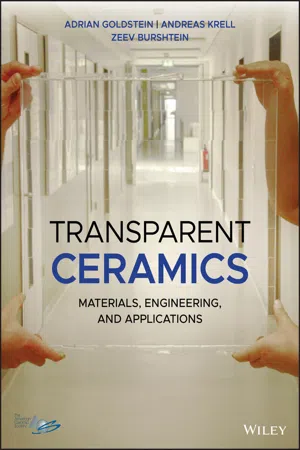1.1 Importance of Transparent Ceramics: The Book's Rationale Topic and Aims
Ceramics constitute a relatively new family of optical materials belonging to a larger class of transparent solids; other members of this class are glasses, single crystals, and some organic polymers [G21].
Overall performance of certain transparent components of many high-tech optical devices may be improved if manufactured using ceramics rather than alternative transparent solids. This is because transparent ceramics offer improved performance and/or robustness. Potentially they may also provide cost benefits to manufacturers. These claims can be exemplified with the case of the first commercially used transparent ceramic, which was translucent alumina Al2O3 (see details in Section 1.5.2). The material has provided its developer (General Electric of the United States) more than half a billion dollars in revenue during the final decades of the last century [B67]. It has been mostly used in the manufacturing of envelopes for high vapor pressure sodium Na streetlamps. Such feat has yet not been replicated. However a number of later developed optical components like armor, sand-blasting installations or chemical reactor windows, infrared (IR) sensor protective domes, solid-state lighting systems, Nd3+ : Y3Al5O12 (Nd:YAG, yttrium–aluminum garnet) light gain media, scintillators, dental prosthetics, lenses, and various decorative objects are also commercialized (small scale) or in the upscaling to industrial manufacturing phase. Quite probably, transparent ceramics fabrication costs will be reduced (a lot of effort and financial resources are invested in this task worldwide), thanks to current research and development efforts, allowing enhanced commercialization of that important technology.
Transparent ceramics study is also relevant for advancing the general ceramics science, as some basic requirements like densification and purity are more stringent. Achievement of such targets requires innovative thinking and new technological approaches, based on deep and comprehensive understanding of underlying physical and chemical processes involved in ceramics engineering.
The above suggests that transparent ceramics may represent a topic of interest for many ceramists and also for people outside this community, like laser, lighting, or military optical systems developers. That potential interest is the rationale for the writing of this book. It intends to summarize the most interesting information accumulated during the 60-year-long history of the transparent ceramics domain: relevant materials, engineering specifics, properties, and applications. The information presented emanates mostly from published literature, but to some extent also from research performed by this book's authors. Emphasis is made on providing critique comparison between certain ceramics performance and their competitor materials per their targeted applications.
Most of the text was written at an introductory level, the main goal being to offer a one-stop broad scope presentation of the topic. To a certain extent, in-depth discussion was sacrificed for practical brevity. Exhaustive presentation, simultaneous with a wide range of considered issues, is obviously a feat difficult to achieve. Some quite modest background of general physics, chemistry, and ceramics science and engineering is sufficient for reasonable comprehension of most of the discussed issues. For a few, seemingly “arcane” yet basic topics, the book provides its own background. Thus, Chapter 2 in its entirety carries such support information. It is devoted to various aspects of electromagnetic radiation interaction with matter; its most important part is the section dealing with the interpretation of electronic spectra produced by transition element cation (TM+) and RE+ dopants. Chapter 3 deals with engineering and characterization of transparent ceramics. The general procedures encountered when dealing with advanced ceramics are also applicable to transparent ceramics. Certain aspects like severity of the demands related to some characteristics, however, are unique to transparent ceramics. Chapter 3 also focuses on these specifics without offering a detailed presentation of operational procedures. These can be found in dedicated excellent textbooks [G12, R5]. Chapter 4 presents the main transparent ceramic materials currently investigated. For each material, the main addressed issues are their structure and specific processing conditions and approaches, allowing fabrication of transparent samples. Those are discussed because the overall benefit of a transparent ceramic is also determined by its other-than-optical properties. Technological applications are treated in Chapter 5. In the chapter, for some of the more complex applications, like laser gain media, a review of the basics of laser physics and engineering is provided; a brief presentation of the projectiles/armor interaction is also preceding the discussion of transparent ceramics armor. For solid-state light sources, the background presents an extended gamut of historic lighting sources. Chapter 6 discusses briefly the further prospects of the domain. The book ends with conclusions related to the previous chapters.
To the best of our knowledge, only a single previous publication exists [K35] that addresses a similar broad scope of transparent ceramics. For a narrower but important domain of transparent ceramics relevant for laser applications, a useful source book authored by A. Ikesue et al. [I3] is available. It is our pleasure to express our appreciation of these previous efforts.
Note for facilitating reading: The text includes a number of abbreviations. The most ubiquitous are defined in a special section located the opening of the book; others, relevant only for specific sections are defined “locally”. For often used parameters, their label is provided in the list of general abbreviations. However in certain places, a different notation had to be used for a parameter; in such cases the “locally” relevant label is indicated. Conversely a given letter may designate different parameters, in different sections; the local correct parameter letter correspondence is always indicated.
